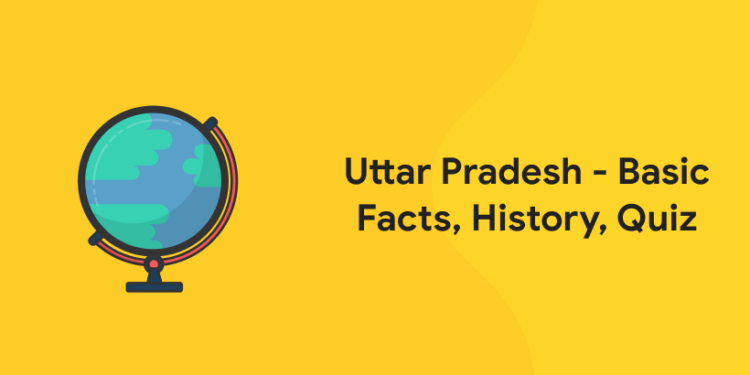Table of Contents
Uttar Pradesh is an Indian state that is located in the country’s northeast region. The state is bordered by Uttarakhand on the north, on the east by Bihar, Rajasthan to the west and on the northwest by Haryana, Himachal Pradesh, Delhi and Madhya Pradesh to the south, and touches the states of Jharkhand and chattisgarh to the south east. Also the state shares an international border with Nepal to the north.It is the most populated state in India as well as the most populous country subdivision in the world. It covers 240,928 km2 (93,023 sq mi), equal to 7.3% of the total area of India. After independence in 1947, the United Provinces were renamed Uttar Pradesh in 1950. In 2000, the state of Uttarakhand was thrashed out from Uttar pradesh.
History of Uttar Pradesh
The state Uttar Pradesh known as UP is the fourth largest Indian state by its area and formed in April 1937, with the state capital being Lucknow and Allahabad serving as the judicial capital and it was awarded separate statehood on 24 January 1950. In February 2017, Yogi Adityanath became the chief minister of Uttar Pradesh. In 2019, the Ayodhya Dispute was settled by The Supreme Court of India. The name was changed once again to Uttar Pradesh in January 1950, under the Constitution of India. From 1902, the province was known as the United Provinces of Agra and Oudh. On 9 November 2000, a new state, Uttaranchal (now Uttarakhand), was created from Uttar Pradesh’s western Himalayan hill region. The two major rivers of the state, the Ganges and its tributary Yamuna, meet at the Triveni Sangam in Allahabad, a Hindu pilgrimage site. Other notable rivers are Gomti and Saryu. The forest cover in the state is 6.1% of the state’s geographical area. The cultivable area is 82% of total geographical area and net area sown is 68.5% of cultivable area.
Uttar Pradesh has a large population and a high population growth rate. From 1991 to 2001 its population increased by over 26%.Uttar Pradesh is the most populous state in India, with 199,581,477 people on 1 March 2011. The state contributes to 16.2% of India’s population. The population density is 828 people per square kilometer, making it one of the most densely populated states in the country. Uttar Pradesh has the largest scheduled caste population whereas scheduled tribes are less than 1 per cent of the total population.
The state is known for sugar production, the state’s economy is now dominated by the services industry. The service sector comprises travel and tourism, hotel industry, real estate, insurance and financial consultancies. The economy of Uttar Pradesh is the third-largest state economy in India with ₹15.12 lakh crore (US$200 billion) in gross domestic product and a per capita GSDP of ₹65,431 (US$870). President’s rule has been imposed in Uttar Pradesh ten times since 1968, for different reasons and for a total of 1,700 days.The state has currently two international airports, Chaudhary Charan Singh Airport (Lucknow) and Lal Bahadur Shastri Airport (Varanasi). Allahabad Junction is the headquarters of the North Central Railway and Gorakhpur Railway Station serves as the headquarters of the North Eastern Railway. The High Court of the state is located in Allahabad. The state contributes 80 seats and 31 seats to the lower house Lok Sabha and to the upper house Rajya Sabha respectively.
In 1920, the capital of the province was shifted from Allahabad to Lucknow.The high court continued to be at Allahabad, but a bench was established at Lucknow. Allahabad continues to be an important administrative base of today’s Uttar Pradesh and has several administrative headquarters. Uttar Pradesh continued to be central to Indian politics and was especially important in modern Indian history as a hotbed of the Indian independence movement. Its political influence since ancient times, its poor record in economic development and administration, poor governance, organised crime and corruption have kept it among India’s backward states. The state has been affected by repeated episodes of caste and communal violence. In Ayodhya in December 1992 the disputed Babri Mosque was demolished by radical Hindu activists, leading to widespread violence across India.In 2000, northern districts of the state were separated to form the state of Uttarakhand. All of Uttar Pradesh were ruled by the Delhi Sultanate for 320 years (1206–1526). Five dynasties ruled over the Delhi Sultanate sequentially: the Mamluk dynasty (1206–90), the Khalji dynasty (1290–1320), the Tughlaq dynasty (1320–1414), the Sayyid dynasty (1414–51), and the Lodi dynasty 1451–1526).
overview
| Capital | Lucknow |
| Chief Minister | Yogi Adityanath |
| Governor | Anandiben Patel |
| Number of Districts | 75 |
| Number of Divisions | 18 |
| Official Languages | Hindi and Urdu |
Basic Facts about Uttar Pradesh
1: Who was the first woman President of India?
- During British rule the name of Uttar Pradesh was United Provinces of Agra Oudh.
- Capital of Uttar Pradesh is Lucknow.
- Uttar Pradesh is the most populous state in India with over 200 million population. It makes up about 16.6% of the population of India. If Uttar Pradesh were a country, It would be the 6th most populous country in the World.
- Presently Uttar Pradesh has 75 districts and 18 divisions.
- The official language of Uttar Pradesh is Hindi and Urdu.
- Nepal is the one and only country which shares the International border with Uttar Pradesh.
- Uttar Pradesh got its statehood on 24 January 1950.
- Yogi Adityanath is the present Chief Minister of Uttar Pradesh.
- Different crops are grown in different regions of Uttar Pradesh. In the north-west region, sugarcane, rice, maize, cotton, etc. are the main crops, and in the south-west region, wheat, rice, mango, guava, oilseed, tobacco, groundnut, potato, are the main crops. In eastern Uttar Pradesh, wheat, rice, and chillies are the main crops.
- It is the 4th largest economy in the country after Maharashtra, Tamil Nadu, Karnataka.
- The two main rivers of the state; Ganga and Yamuna flow through the state before emptying into the Bay of Bengal.
- Dudhwa National Park, Lakhimpur Kheri is the only national park in the state. There are several tiger reserves and wildlife sanctuaries in the state such as Bakhira wildlife sanctuary, Pilibhit Tiger Reserve, Parvati Arga Bird Sanctuary, Gonda, Saman Sanctuary, Mainpuri, etc.
- Uttar Pradesh ranks at the top in tourism. Uttar Pradesh is visited by more than 7 million international tourists each year which is highest among all Indian states.
- Uttar Pradesh has 80 Lok sabha seats and 31 Raj sabha seats.
Attempt free GK Mock Test! Download Entri App
GK Quiz on Uttar Pradesh
Q.1.When did Uttar Pradesh get its Statehood?
Answer: 24 January 1950
Q.2.Which State in India is the Most Populous State?
Answer: Uttar Pradesh
Q.3. What is the Capital of Uttar Pradesh?
Answer: Lucknow
Q.4.How many Divisions are in Uttar Pradesh?
Answer: 18 Divisions
Q.5.How many Districts are in Uttar Pradesh?
Answer: 75 Districts
Q.6.Who were the Two Former Female Chief Ministers of Uttar Pradesh?
Answer: Sucheta Kripalani and Mayawati
Q.7.What is the Official Language of Uttar Pradesh?
Answer: Hindi and Urdu
Q.8.Who is the Chief Minister Of Uttar Pradesh?
Answer: Yogi Adityanath
Q.9.Which are the Major Rivers that Flows through Uttar Pradesh?
Answer:
1) Ganga
2) Gomti
3) Saraswati
4) Varuna
5) Yamuna
Q.10. How many Seats does Uttar Pradesh have in Lok Sabha?
Answer: 80 Seats
Q.11.Which are the Two Most Populous Religions in Uttar Pradesh?
Answer: Hinduism and Islam
Q.12.How many Seats does Uttar Pradesh have in Rajya Sabha?
Answer: 31 Seats
Q.13.Which is the Largest Police Force in the World?
Answer: Uttar Pradesh Police
Q.14.How many Central Universities are there in Uttar Pradesh?
Answer: Six
Q.15.How many IITs are in Uttar Pradesh?
Answer: Two
1) IIT Kanpur
2) IIT (BHU) Varanasi
Q.16.Which place is also known as the Birth Place of Lord Rama?
Answer: Ayodhya
Q.17.Who was the first Governor of Uttar Pradesh?
Answer: Sarojini Naidu
Q.18.Which one is the largest district in Uttar Pradesh by area wise?
Answer: Lakhimpur Kheri
Q.19.When was Uttaranchal separated from Uttar Pradesh?
Answer: 8 November 2000
Q.20.What are the State Symbols of Uttar Pradesh?
Answer:
1) Animal: Swamp Deer
2) Bird: Sarus Crane
3) Dance: Kathak
4) Flower: Palash
5) Sport: Field Hockey
6) Tree: Ashoka













